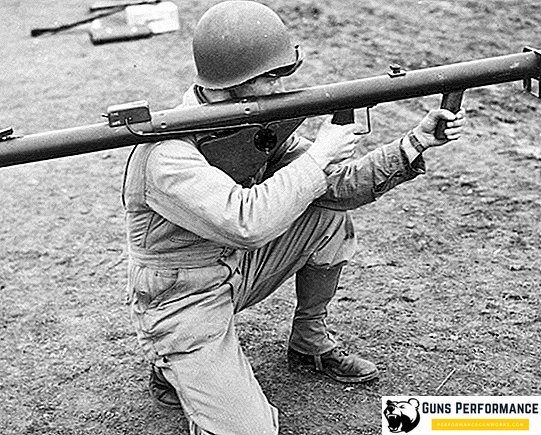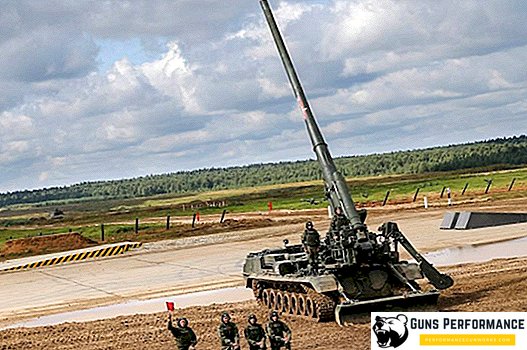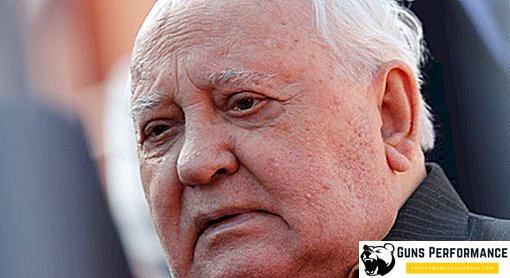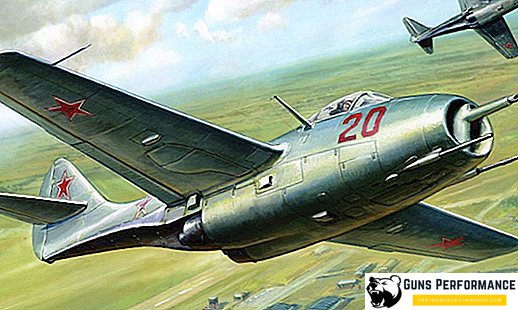
The Bazooka (Bazooka) is an American hand-held anti-tank grenade launcher adopted for service in 1942. It was he who became the ancestor of a new type of weapon, which in the future put an end to tank hegemony on the battlefield. "Bazooka" was the first hand-held grenade launcher in the world, after studying the captured samples of these weapons, the Germans created their famous "Faustpatron".
The name of this grenade came from a musical instrument, which had the form of a straight sliding hollow tube, invented in the USA at the beginning of the last century. Later the name "bazooka" became a household name, especially in the United States. So they began to call any grenade launcher, and just a powerful and big weapon.
Bazooka was the result of work on the creation of anti-tank missile weapons held in the United States since the early 30s.

History of the RPG "Bazooka"
Tanks, having first appeared on the battlefields of the First World War in the form of bulky and unreliable mechanisms, after a few years began to be a formidable force, becoming the main offensive weapon. The fight against tanks has become one of the main tasks of the infantry.
Before the beginning of World War II, the main anti-tank weapons of the American army were 37-mm guns and rifle grenades, which were fired using special nozzles that were mounted on the barrel of a weapon. The most powerful rifle grenade of the US Army was the M10, but its use caused a lot of complaints from the military. It was necessary to have a compact and maneuverable means of fighting the enemy’s armored vehicles, which would fill the niche between grenades and anti-tank guns.

At the same time, in the USA, active work was being done on the creation of reactive anti-tank weapons based on a recoilless principle. However, initially the American grenade launchers fired high-explosive ammunition, which did not allow to turn them into a truly effective anti-tank weapon. The optimal and simple solution was found in 1942: two US military suggested combining the cumulative warhead of a M10 rifle grenade and a high-explosive ordnance rocket engine. And so the world's first Bazooka anti-tank grenade launcher appeared.
The new weapon turned out so successful that its production began even before its official adoption. The first batch of "Bazook" was put in the troops before the landing operation Torch ("Torch") in North Africa. It amounted to 5 thousand grenade launchers and 25 thousand rockets to them. Cumulative grenades punched up to 90 mm of homogeneous armor and were effective against all types of German and Italian armored vehicles. True, when shooting, the scattering of grenades was significant, which seriously reduced the effective range of these weapons, but the American generals recognized this shortcoming as valid.

The Germans, having familiarized themselves with the Bazook trophy samples, very soon launched Offenrohr and Panzerschreck in mass production.
Like any new weapon, "Bazooka" had numerous "childhood diseases", which very quickly appeared during its operation. The length of the launch tube was not very convenient during transportation, the dry electric batteries that were used to launch the rocket were unreliable, and the heated exhaust gases of the missile could have injured the shooter. In addition, the launch tube was often torn when fired.
To correct the identified deficiencies Bazooka has undergone modernization. A new modification of the weapon received the designation M1A1, it was launched into mass production in the summer of 1943.
The mass of the new modification was reduced while maintaining the same size, in order to avoid rupture of the launch tube during the shot, it was reinforced with steel wire. The front handle was refused, and in order to protect the shooter’s face from hot gases, a protective shield was installed on the front edge of the pipe. The rocket electric launch system was also changed.
It should be noted that grenades for the new modification of the M1A1 were not suitable for the basic model of weapons, which complicated the supply.
After the landing of the Americans in Normandy, they were faced with heavy German tanks, which forced the creators of the Bazooka to urgently increase its armor penetration.

In 1943, a modification of the M9 grenade launcher was adopted by the American army, in which the designers tried to correct all the shortcomings of the previous models. Now the launch tube was assembled in two parts, which was very convenient for transportation, its length increased to 1,550 mm. Capricious electric batteries were replaced by an induction generator placed in the pistol grip. The wooden shoulder rest was replaced by aluminum, and the protective shield was replaced by a socket. The new "Bazooka" received an optical sight, which increased the range of sight to 640 meters.

A separate problem was the lack of armor penetration grenade launchers. This problem was solved by a significant modernization of the rocket grenade. Now she had a rounded front, which significantly reduced the likelihood of rebound. The grenade received a cylindrical stabilizer (this improved flight stability), as well as a new (copper) lining of the cumulative notch. This allowed increasing armor penetration to 100 mm of homogeneous armor.
The range of ammunition was also expanded: now Bazooka could shoot smoke and anti-personnel fragmentation grenades.
In April 1944, the modification M9A1 was adopted, it was able to penetrate armor 120 mm thick.
In 1945 another modification of the grenade launcher appeared - the M18. Externally, this "Bazooka" was no different from its predecessors (M9 and M9A1), but aluminum was actively used in its design. This made it possible to reduce the mass of the weapon by almost two kilograms and make it less susceptible to corrosion.

The high effectiveness of the use of powerful German Panzerschreck prompted American designers to create at the end of the war a 90-mm M20 grenade launcher "Super Baz." Despite the external similarity with the Panzerschreck, the American grenade launcher surpassed the German rival in all respects: it was 20% lighter, had greater armor penetration and firing rate.
Description of the construction of a grenade launcher "Bazuki"

The Bazooka manual grenade launcher consisted of a 1370 mm smooth-walled pipe, a caliber of 60 mm, a safety box, an electric igniter, a shoulder rest, two pistol grip arms and sighting devices. The mass of weapons was 8 kg.
A ring was located at the rear end of the pipe, which facilitated the loading of the grenade launcher, as well as the latch, which prevented the fallout of the ammunition and closed the electrical circuit. At the front end of the pipe was placed flap, protecting the arrow from the stream of hot exhaust gases grenades.
The electric ignition device of the grenade launcher consisted of two batteries, located in the shoulder rest, a signal light bulb, electrical wiring and a trigger, which served as a circuit breaker.

The sights of the first modifications of the Bazuki are a front frame with three front sights and a folding viewfinder.
The calculation of the grenade launcher consisted of two people: an arrow and loader.
Characteristics of RPG "Bazooka"
| Modification | M1 Bazooka |
| Caliber | 60 mm |
| Type of | reactive |
| Length | 1370 mm |
| Weight (empty) | 8.0 kg |
| Effective range | ~ 300 meters |
| Armor penetration | 90-100mm |












